CREATE TABLE `lc_c_user_path` ( `id` INT ( 10 ) UNSIGNED NOT NULL AUTO_INCREMENT, `user_id` VARCHAR ( 20 ) NOT NULL COMMENT '用户标识', `username` VARCHAR ( 100 ) DEFAULT NULL COMMENT '用户名', `store_id` VARCHAR ( 20 ) DEFAULT NULL COMMENT '店铺id', `user_id_path` text COMMENT '当前用户上级用户标识', `username_path` text COMMENT '当前用户上级用户账号', `store_id_path` text COMMENT '当前用户上级用户店铺', `complete_path` text COMMENT '绑定邀请码的用户path', PRIMARY KEY ( `id` ), UNIQUE KEY `IDX_U_I` ( `user_id` ) USING BTREE ) ENGINE = INNODB AUTO_INCREMENT = 16 DEFAULT CHARSET = utf8 COMMENT = '用户user_id,username,store之间转化';

INSERT INTO `lc_c_user_path`(`id`, `user_id`, `username`, `store_id`, `user_id_path`, `username_path`, `store_id_path`, `complete_path`) VALUES (1, 'us1', 'un1', 's1', 'us0', 'un0', 's0', 'us0'); INSERT INTO `lc_c_user_path`(`id`, `user_id`, `username`, `store_id`, `user_id_path`, `username_path`, `store_id_path`, `complete_path`) VALUES (2, 'us2', 'un2', 's2', 'us1/us0', 'un1/un0', 's1/s0', 'us1/us0'); INSERT INTO `lc_c_user_path`(`id`, `user_id`, `username`, `store_id`, `user_id_path`, `username_path`, `store_id_path`, `complete_path`) VALUES (3, 'us3', 'un3', 's3', 'us2/us1/us0', 'un2/un1/un0', 's2/s1/s0', 'us2/us1/us0'); INSERT INTO `lc_c_user_path`(`id`, `user_id`, `username`, `store_id`, `user_id_path`, `username_path`, `store_id_path`, `complete_path`) VALUES (4, 'us4', 'un4', NULL, 'us3/us2/us1/us0', 'un3/un2/un1/un0', 's3/s2/s1/s0', 'us3/us2/us1/us0'); INSERT INTO `lc_c_user_path`(`id`, `user_id`, `username`, `store_id`, `user_id_path`, `username_path`, `store_id_path`, `complete_path`) VALUES (5, 'us5', 'un5', 's5', 'us3/us2/us1/us0', 'un3/un2/un1/un0', 's3/s2/s1/s0', 'us4/us3/us2/us1/us0'); INSERT INTO `lc_c_user_path`(`id`, `user_id`, `username`, `store_id`, `user_id_path`, `username_path`, `store_id_path`, `complete_path`) VALUES (6, 'us6', 'un6', 's6', 'us5/us3/us2/us1/us0', 'un5/un3/un2/un1/un0', 's5/s3/s2/s1/s0', 'us5/us4/us3/us2/us1/us0'); INSERT INTO `lc_c_user_path`(`id`, `user_id`, `username`, `store_id`, `user_id_path`, `username_path`, `store_id_path`, `complete_path`) VALUES (7, 'us7', 'un7', 's7', 'us6/us5/us3/us2/us1/us0', 'un6/un5/un3/un2/un1/un0', 's6/s5/s3/s2/s1/s0', 'us6/us5/us4/us3/us2/us1/us0'); INSERT INTO `lc_c_user_path`(`id`, `user_id`, `username`, `store_id`, `user_id_path`, `username_path`, `store_id_path`, `complete_path`) VALUES (8, 'us8', 'un8', 's8', 'us7/us6/us5/us3/us2/us1/us0', 'un7/un6/un5/un3/un2/un1/un0', 's7/s6/s5/s3/s2/s1/s0', 'us7/us6/us5/us4/us3/us2/us1/us0'); INSERT INTO `lc_c_user_path`(`id`, `user_id`, `username`, `store_id`, `user_id_path`, `username_path`, `store_id_path`, `complete_path`) VALUES (9, 'us9', 'un9', '', 'us8/us7/us6/us5/us3/us2/us1/us0', 'un8/un7/un6/un5/un3/un2/un1/un0', 's8/s7/s6/s5/s3/s2/s1/s0', 'us8/us7/us6/us5/us4/us3/us2/us1/us0'); INSERT INTO `lc_c_user_path`(`id`, `user_id`, `username`, `store_id`, `user_id_path`, `username_path`, `store_id_path`, `complete_path`) VALUES (10, 'us10', 'un10', 's10', 'us8/us7/us6/us5/us3/us2/us1/us0', 'un8/un7/un6/un5/un3/un2/un1/un0', 's8/s7/s6/s5/s3/s2/s1/s0', 'us9/us8/us7/us6/us5/us4/us3/us2/us1/us0'); INSERT INTO `lc_c_user_path`(`id`, `user_id`, `username`, `store_id`, `user_id_path`, `username_path`, `store_id_path`, `complete_path`) VALUES (11, 'us11', 'un11', 's11', 'us10/us8/us7/us6/us5/us3/us2/us1/us0', 'un10/un8/un7/un6/un5/un3/un2/un1/un0', 's10/s8/s7/s6/s5/s3/s2/s1/s0', 'us10/us9/us8/us7/us6/us5/us4/us3/us2/us1/us0'); INSERT INTO `lc_c_user_path`(`id`, `user_id`, `username`, `store_id`, `user_id_path`, `username_path`, `store_id_path`, `complete_path`) VALUES (12, 'us12', 'un12', '', 'us11/us10/us8/us7/us6/us5/us3/us2/us1/us0', 'un11/un10/un8/un7/un6/un5/un3/un2/un1/un0', 's11/s10/s8/s7/s6/s5/s3/s2/s1/s0', 'us11/us10/us9/us8/us7/us6/us5/us4/us3/us2/us1/us0'); INSERT INTO `lc_c_user_path`(`id`, `user_id`, `username`, `store_id`, `user_id_path`, `username_path`, `store_id_path`, `complete_path`) VALUES (13, 'us13', 'un13', 's13', 'us11/us10/us8/us7/us6/us5/us3/us2/us1/us0', 'un11/un10/un8/un7/un6/un5/un3/un2/un1/un0', 's11/s10/s8/s7/s6/s5/s3/s2/s1/s0', 'us12/us11/us10/us9/us8/us7/us6/us5/us4/us3/us2/us1/us0'); INSERT INTO `lc_c_user_path`(`id`, `user_id`, `username`, `store_id`, `user_id_path`, `username_path`, `store_id_path`, `complete_path`) VALUES (14, 'us14', 'un14', 's14', 'us13/us11/us10/us8/us7/us6/us5/us3/us2/us1/us0', 'un13/un11/un10/un8/un7/un6/un5/un3/un2/un1/un0', 's13/s11/s10/s8/s7/s6/s5/s3/s2/s1/s0', 'us13/us12/us11/us10/us9/us8/us7/us6/us5/us4/us3/us2/us1/us0'); INSERT INTO `lc_c_user_path`(`id`, `user_id`, `username`, `store_id`, `user_id_path`, `username_path`, `store_id_path`, `complete_path`) VALUES (15, 'us15', 'un15', 's15', 'us14/us13/us11/us10/us8/us7/us6/us5/us3/us2/us1/us0', 'un14/un13/un11/un10/un8/un7/un6/un5/un3/un2/un1/un0', 's14/s13/s11/s10/s8/s7/s6/s5/s3/s2/s1/s0', 'us14/us13/us12/us11/us10/us9/us8/us7/us6/us5/us4/us3/us2/us1/us0'); INSERT INTO `lc_c_user_path`(`id`, `user_id`, `username`, `store_id`, `user_id_path`, `username_path`, `store_id_path`, `complete_path`) VALUES (16, 'us16', 'un16', 's16', 'us1/us0', 'un1/un0', 's1/s0', 'us1/us0'); INSERT INTO `lc_c_user_path`(`id`, `user_id`, `username`, `store_id`, `user_id_path`, `username_path`, `store_id_path`, `complete_path`) VALUES (17, 'us17', 'un17', 's17', 'us16/us1/us0', 'un16/un1/un0', 's16/s1/s0', 'us16/us1/us0'); INSERT INTO `lc_c_user_path`(`id`, `user_id`, `username`, `store_id`, `user_id_path`, `username_path`, `store_id_path`, `complete_path`) VALUES (18, 'us18', 'un18', 's18', 'us3/us2/us1/us0', 'un3/un2/un1/un0', 's3/s2/s1/s0', 'us3/us2/us1/us0'); INSERT INTO `lc_c_user_path`(`id`, `user_id`, `username`, `store_id`, `user_id_path`, `username_path`, `store_id_path`, `complete_path`) VALUES (19, 'us19', 'un19', 's19', 'us18/us3/us2/us1/us0', 'un18/un3/un2/un1/un0', 's18/s3/s2/s1/s0', 'us18/us3/us2/us1/us0');

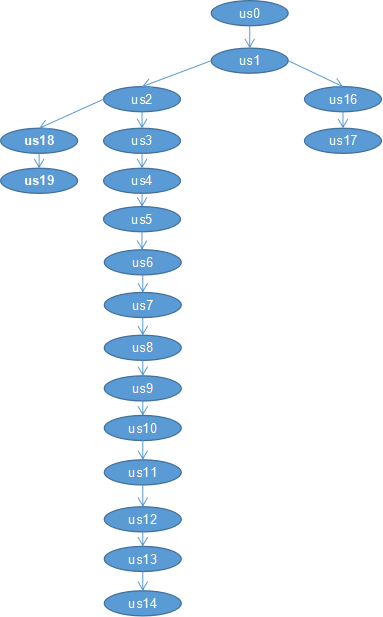
CREATE TABLE `lc_c_customer` ( `id` int(10) unsigned NOT NULL AUTO_INCREMENT, `user_id` varchar(20) NOT NULL COMMENT '用户标识', `partent_user_id` varchar(20) DEFAULT NULL COMMENT '上级店铺id', `pid` varchar(20) DEFAULT NULL COMMENT '当前用户上级用户标识', PRIMARY KEY (`id`), UNIQUE KEY `IDX_U_I` (`user_id`) USING BTREE ) ENGINE=InnoDB AUTO_INCREMENT=20 DEFAULT CHARSET=utf8 COMMENT='用户表';

INSERT INTO `lc_c_customer`(`id`, `user_id`, `partent_user_id`, `pid`) VALUES (1, 'us1', NULL, 'us0'); INSERT INTO `lc_c_customer`(`id`, `user_id`, `partent_user_id`, `pid`) VALUES (2, 'us2', 'us1', 'us1'); INSERT INTO `lc_c_customer`(`id`, `user_id`, `partent_user_id`, `pid`) VALUES (3, 'us3', 'us2', 'us2'); INSERT INTO `lc_c_customer`(`id`, `user_id`, `partent_user_id`, `pid`) VALUES (4, 'us4', 'us3', 'us3'); INSERT INTO `lc_c_customer`(`id`, `user_id`, `partent_user_id`, `pid`) VALUES (5, 'us5', 'us3', 'us4'); INSERT INTO `lc_c_customer`(`id`, `user_id`, `partent_user_id`, `pid`) VALUES (6, 'us6', 'us5', 'us5'); INSERT INTO `lc_c_customer`(`id`, `user_id`, `partent_user_id`, `pid`) VALUES (7, 'us7', 'us6', 'us6'); INSERT INTO `lc_c_customer`(`id`, `user_id`, `partent_user_id`, `pid`) VALUES (8, 'us8', 'us7', 'us7'); INSERT INTO `lc_c_customer`(`id`, `user_id`, `partent_user_id`, `pid`) VALUES (9, 'us9', 'us8', 'us8'); INSERT INTO `lc_c_customer`(`id`, `user_id`, `partent_user_id`, `pid`) VALUES (10, 'us10', 'us8', 'us9'); INSERT INTO `lc_c_customer`(`id`, `user_id`, `partent_user_id`, `pid`) VALUES (11, 'us11', 'us10', 'us10'); INSERT INTO `lc_c_customer`(`id`, `user_id`, `partent_user_id`, `pid`) VALUES (12, 'us12', 'us11', 'us11'); INSERT INTO `lc_c_customer`(`id`, `user_id`, `partent_user_id`, `pid`) VALUES (13, 'us13', 'us11', 'us12'); INSERT INTO `lc_c_customer`(`id`, `user_id`, `partent_user_id`, `pid`) VALUES (14, 'us14', 'us13', 'us13'); INSERT INTO `lc_c_customer`(`id`, `user_id`, `partent_user_id`, `pid`) VALUES (15, 'us15', 'us14', 'us14'); INSERT INTO `lc_c_customer`(`id`, `user_id`, `partent_user_id`, `pid`) VALUES (16, 'us16', 'us1', 'us15'); INSERT INTO `lc_c_customer`(`id`, `user_id`, `partent_user_id`, `pid`) VALUES (17, 'us17', 'us16', 'us16'); INSERT INTO `lc_c_customer`(`id`, `user_id`, `partent_user_id`, `pid`) VALUES (18, 'us18', 'us3', 'us17'); INSERT INTO `lc_c_customer`(`id`, `user_id`, `partent_user_id`, `pid`) VALUES (19, 'us19', 'us18', 'us18');
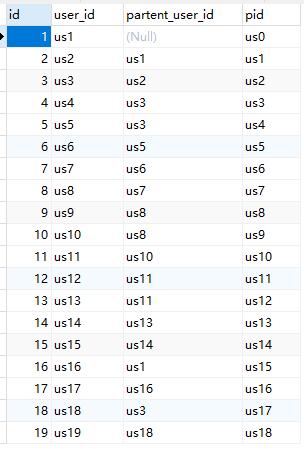
CREATE TABLE `lc_c_store` ( `id` varchar(20) NOT NULL, `user_id` varchar(20) NOT NULL DEFAULT '0' COMMENT '客户id', `name` varchar(64) DEFAULT '0' COMMENT '店铺名字', PRIMARY KEY (`id`), UNIQUE KEY `IDX_U` (`user_id`) ) ENGINE=InnoDB DEFAULT CHARSET=utf8 COMMENT='店铺表';

INSERT INTO `lc_c_store`(`id`, `user_id`, `name`) VALUES ('s1', 'us1', 'us1的云店'); INSERT INTO `lc_c_store`(`id`, `user_id`, `name`) VALUES ('s10', 'us10', 'us10的云店'); INSERT INTO `lc_c_store`(`id`, `user_id`, `name`) VALUES ('s11', 'us11', 'us11的云店'); INSERT INTO `lc_c_store`(`id`, `user_id`, `name`) VALUES ('s13', 'us13', 'us13的云店'); INSERT INTO `lc_c_store`(`id`, `user_id`, `name`) VALUES ('s14', 'us14', 'us14的云店'); INSERT INTO `lc_c_store`(`id`, `user_id`, `name`) VALUES ('s15', 'us15', 'us15的云店'); INSERT INTO `lc_c_store`(`id`, `user_id`, `name`) VALUES ('s16', 'us16', 'us16的云店'); INSERT INTO `lc_c_store`(`id`, `user_id`, `name`) VALUES ('s17', 'us17', 'us17的云店'); INSERT INTO `lc_c_store`(`id`, `user_id`, `name`) VALUES ('s18', 'us18', 'us18的云店'); INSERT INTO `lc_c_store`(`id`, `user_id`, `name`) VALUES ('s19', 'us19', 'us19的云店'); INSERT INTO `lc_c_store`(`id`, `user_id`, `name`) VALUES ('s2', 'us2', 'us2的云店'); INSERT INTO `lc_c_store`(`id`, `user_id`, `name`) VALUES ('s3', 'us3', 'us3的云店'); INSERT INTO `lc_c_store`(`id`, `user_id`, `name`) VALUES ('s5', 'us5', 'us5的云店'); INSERT INTO `lc_c_store`(`id`, `user_id`, `name`) VALUES ('s6', 'us6', 'us6的云店'); INSERT INTO `lc_c_store`(`id`, `user_id`, `name`) VALUES ('s7', 'us7', 'us7的云店'); INSERT INTO `lc_c_store`(`id`, `user_id`, `name`) VALUES ('s8', 'us8', 'us8的云店');
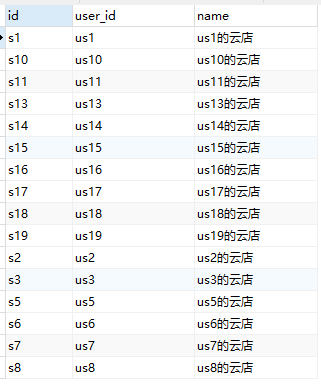
CREATE TABLE `lc_c_store_general` ( `id` bigint(11) unsigned NOT NULL AUTO_INCREMENT, `store_id` varchar(20) DEFAULT NULL COMMENT '对应店铺表id', `user_count` bigint(11) DEFAULT '0' COMMENT '客户数,即 下一级别的用户数', PRIMARY KEY (`id`) ) ENGINE=InnoDB AUTO_INCREMENT=17 DEFAULT CHARSET=utf8 COMMENT='店铺销售数据表';

INSERT INTO `lc_c_store_general`(`id`, `store_id`, `user_count`) VALUES (1, 's1', 2); INSERT INTO `lc_c_store_general`(`id`, `store_id`, `user_count`) VALUES (2, 's2', 1); INSERT INTO `lc_c_store_general`(`id`, `store_id`, `user_count`) VALUES (3, 's3', 3); INSERT INTO `lc_c_store_general`(`id`, `store_id`, `user_count`) VALUES (4, 's5', 1); INSERT INTO `lc_c_store_general`(`id`, `store_id`, `user_count`) VALUES (5, 's6', 1); INSERT INTO `lc_c_store_general`(`id`, `store_id`, `user_count`) VALUES (6, 's7', 1); INSERT INTO `lc_c_store_general`(`id`, `store_id`, `user_count`) VALUES (7, 's8', 2); INSERT INTO `lc_c_store_general`(`id`, `store_id`, `user_count`) VALUES (8, 's10', 1); INSERT INTO `lc_c_store_general`(`id`, `store_id`, `user_count`) VALUES (9, 's11', 2); INSERT INTO `lc_c_store_general`(`id`, `store_id`, `user_count`) VALUES (10, 's13', 1); INSERT INTO `lc_c_store_general`(`id`, `store_id`, `user_count`) VALUES (11, 's14', 1); INSERT INTO `lc_c_store_general`(`id`, `store_id`, `user_count`) VALUES (12, 's15', 0); INSERT INTO `lc_c_store_general`(`id`, `store_id`, `user_count`) VALUES (13, 's16', 1); INSERT INTO `lc_c_store_general`(`id`, `store_id`, `user_count`) VALUES (14, 's17', 0); INSERT INTO `lc_c_store_general`(`id`, `store_id`, `user_count`) VALUES (15, 's18', 1); INSERT INTO `lc_c_store_general`(`id`, `store_id`, `user_count`) VALUES (16, 's19', 0);
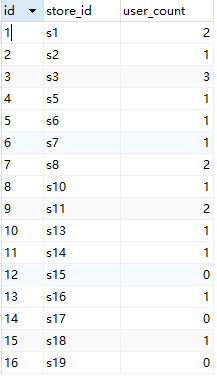
查看用户us2的上级path complete_path
select * from lc_c_user_path where user_id='us2';

查看用户us2的所有下级用户
select * from lc_c_user_path where complete_path like '%us2/us1/us0';


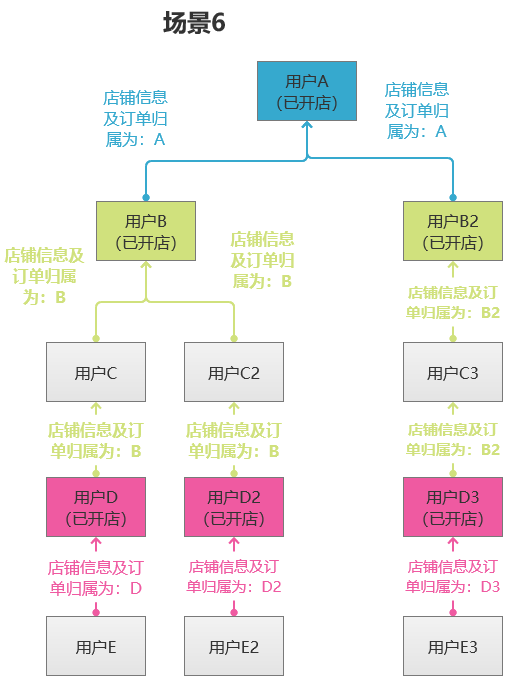
某个开店用户下的客户数
select partent_user_id,count(1) as count from lc_c_customer where 1=1 GROUP BY partent_user_id
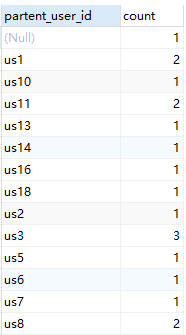
当某个店铺开店,更新lc_c_customer表的partent_user_id字段,即更新当前开店用户的所有下级的partent_user_id,此partent_user_id为最近的已开店的上级的user_id

partent_user_id可以通过获取user_id_path的第一个就是它的直接上级的已开店的partent_user_id
参考代码:

/** * desc 更新用户链条关系 */ public function upUserChain(){ $where['create_time']=array('gt',"2016-01-01 00:00:00"); $storeM=M('c_store'); $data=$storeM->where($where)->order('create_time asc')->find(); if(empty($data)){ exit('没有数据需要更新'); } $openStoreUserId=$data['user_id']; $up_date=$data['create_time']; //查询当前店铺的 对应的userPath信息 $userPathM=M('c_user_path'); $whereUP['user_id']=$openStoreUserId; $field='user_id,username,store_id,user_id_path,username_path,store_id_path,complete_path'; $currentUserInfo=$userPathM->where($whereUP)->field($field)->find(); if(empty($currentUserInfo)){ exit('当前店铺不存在user_path'); } //查询当前店铺的 对应的所有下级 $pidPath=$openStoreUserId.'/'.$currentUserInfo['complete_path']; $whereAllSubordinate['complete_path']=array('like',"%{$pidPath}"); //按id升序 $list=$userPathM->where($whereAllSubordinate)->order('id asc')->field($field)->select(); //需要更新lc_store_general数据的店铺 -- 开店 + 开店所有下级(开店)+ 直接上级(开店) $needUpStoreArr=array(); $needUpStoreArr[]=$currentUserInfo['store_id'];//开店 $store_id_path=$currentUserInfo['store_id_path']; $storeIdPathArr=explode('/',$store_id_path); $needUpStoreArr[]=reset($storeIdPathArr);//上级蜂店 try{ if(empty($list)){ exit('当前店铺无下级,更新完毕!'); } //存在下级的情况 //更新lc_user_path 几个上级蜂店path //更新所有下级的parent_user_id $needUpPUIArr=array(); M()->startTrans(); foreach ($list as $key => $value) { //当前用户的直接上级 $complete_path=$value['complete_path']; $completePathArr=explode('/',$complete_path); $firstLevel=reset($completePathArr); //判断当前用户是否开店 if(!empty($value['store_id'])){//说明已经开店--更新lc_store_general数据 $needUpStoreArr[]=$value['store_id']; } //判断当前用户的直接上级 $wherCurrenSuperior['user_id']=$firstLevel; $currenSuperiorInfo=$userPathM->where($wherCurrenSuperior)->field($field)->find(); //判断当前用户的上级是否开店 if(!empty($currenSuperiorInfo['store_id'])){//说明已经开店 $newUserIdPath=$currenSuperiorInfo['user_id'].'/'.$currenSuperiorInfo['user_id_path'];//上级蜂店用户编号+上级蜂店用户父级编号=当前用户的上级蜂店用户编号 $newUserNamePath=$currenSuperiorInfo['username'].'/'.$currenSuperiorInfo['username_path'];//上级蜂店用户username+上级蜂店用户父级username=当前用户的上级蜂店用户username $newStoreIdPath=$currenSuperiorInfo['store_id'].'/'.$currenSuperiorInfo['store_id_path'];//上级蜂店用户店铺编号+上级蜂店用户父级店铺编号=当前用户的上级蜂店用户店铺编号 //当前用户的上级蜂店 $firstStoreUserLevel=$currenSuperiorInfo['user_id']; }else{ //上级没有开店 所有的店铺相关path 都和上级一样 $newUserIdPath=$currenSuperiorInfo['user_id_path']; $newUserNamePath=$currenSuperiorInfo['username_path']; $newStoreIdPath=$currenSuperiorInfo['store_id_path']; //当前用户的上级蜂店 $userIdPathArr=explode('/',$newUserIdPath); $firstStoreUserLevel=reset($userIdPathArr); } $needUpPUIArr[$value['user_id']]=$firstStoreUserLevel; $whereUp['user_id']=$value['user_id']; $upData=array( 'user_id_path'=>$newUserIdPath, 'username_path'=>$newUserNamePath, 'store_id_path'=>$newStoreIdPath, ); $reUp=$userPathM->where($whereUp)->data($upData)->save(); if($reUp===false){ E('210001','更新user_path失败'); } } M()->commit(); exit('执行成功'); }catch (Exception $ex) { M()->rollback(); $curCode=$ex->getErrorCode(); $curmsg=$ex->getMessage(); exit($curmsg); } }
